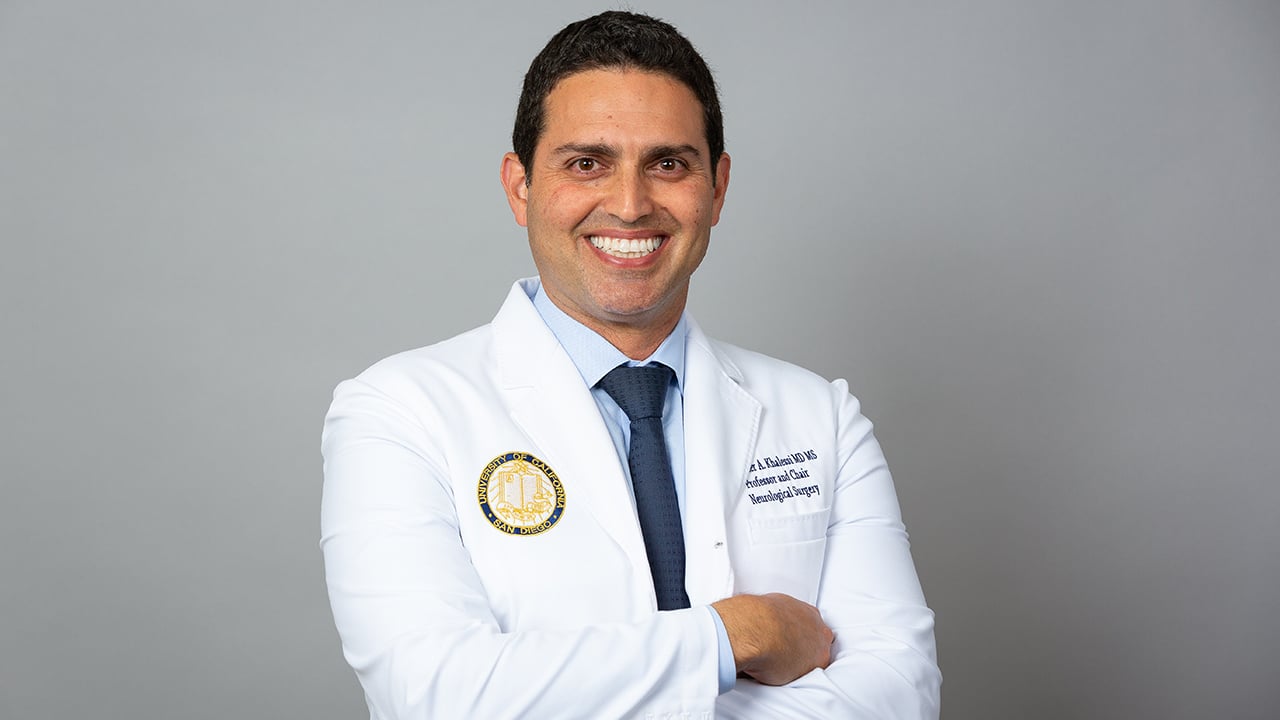Deep Brain Stimulation
Medication can help people with movement disorders control symptoms, but over time the effect of medication on symptoms can subside. When movement control becomes more difficult and impedes your lifestyle, it may be time to consider surgical intervention.
As the first to introduce deep brain stimulation (DBS) therapy in San Diego, our Movement Disorders Program has been advancing our knowledge of this technique ever since. We are the only center to offer frameless DBS in San Diego County.
Our team of movement disorder specialists — a neurosurgeon, neuropsychologists, a nurse practitioner, and physical, speech and occupational therapists — conduct an in-depth evaluation before considering patients for deep brain stimulation.
What is DBS?
Deep brain stimulation (DBS) is a surgical procedure to treat movement disorders. It was approved by the FDA in 1997.
DBS is recommended for patients on long-term medication to regain movement control and improve quality of life. Studies have shown that patients with Parkinson's disease who have both DBS therapy and medication therapy live longer than patients who are on medication therapy alone. Read more about this research at Pubmed.gov.
DBS delivers electrical stimulation in carefully mapped sites of your brain through embedded electrodes, much like a cardiac pacemaker. This low-level electrical stimulation helps synchronize the motor networks in the brain. DBS can help ease the burden of prescription therapy for movement disorders most commonly associated with Parkinson’s disease, essential tremor and dystonia.
DBS is best suited for motor symptoms related to:
- Parkinson's disease
- Essential tremor (ET)
- Dystonia
- Tic/Tourette syndrome
DBS therapy requires hard work and cooperation between the patient, family and the movement disorder team. A person's age, good general health and a realistic expectation of the outcome are critical in achieving success.
People who are in earlier stages of disease and just beginning to lose the ability to perform meaningful activities — despite optimal medical therapy — can benefit greatly from DBS. Unfortunately, DBS cannot rescue someone with end-stage Parkinson's disease, nor is it a cure for Parkinson’s disease.
Insurance
Medicare and most private insurers cover the deep brain stimulation procedure.
Monthly Meet-Up
Considering DBS?
Join us for an informal gathering at Thornton Pavilion (Jacobs Medical Center) where patients and families can ask questions and learn more about deep brain stimulation.
Comprehensive Evaluation
At UC San Diego Health, potential DBS candidates receive two comprehensive evaluations: one while on their current medications, and another off their medications. This allows us to assess what kind of results can be expected and determine if proceeding with DBS is feasible. The team of specialists will also determine what type of DBS procedure is most appropriate.
Candidates undergo a CT scan and MRI of the brain to map activity that can help pinpoint the exact region for electrode placement. In most cases the type of movement disorder plays a major role in choosing a target region of the brain.
DBS Procedures
Frameless DBS
We perform DBS using a frameless technique. Unlike the conventional stereotactic frame, frameless DBS surgery is much more comfortable for patients.
Awake DBS
Traditionally, DBS surgery is conducted while the patient is awake, and under pain management. This approach allows surgeons to continuously monitor the patient’s brain function and ensure accurate placement of the device.
After local anesthesia is administered, listening electrodes (brain activity monitors) are used to register your brain activity. The neurosurgeon records your brain’s electrical impulses as you perform tasks such as moving your limbs and reading, made easier by the frameless system.
We are the first in San Diego to use a new CT-based guidance system to perform DBS on an awake patient with essential tremor.
A week after the electrode insertion, the patient returns to have the DBS control module surgically embedded. The control module is implanted below the collarbone and wired under the skin to the electrode in the brain. This is a same-day outpatient procedure.
After the DBS Procedure
Results can be dramatic in patients with dystonia, Parkinson’s and essential tremor, with significant improvement to motor function and control over body movements. Our highly qualified team of physical therapists and speech pathologists play a crucial role in post-operative recovery and will help you through rehabilitation.
Programming the brain stimulator involves neurological expertise and close monitoring of symptoms. Techniques like the Lee Silverman Voice Treatment approach and neuromuscular electrical stimulation will strengthen your mind and body’s resolve to heal, while we work with you to achieve optimal results.
Components of the Deep Brain Stimulator
The deep brain stimulator consists of two major components connected by an insulated wire that is concealed under your skin.
The DBS electrode, about the width of a single strand of spaghetti, is inserted with a guidance catheter through a small opening in the skull into a pre-determined part of the brain.
Depending on your condition, this could be the:
- Thalamus (VIM)
- Subthalamic nucleus (STN)
- Internal globus pallidus (GPi)
The control module of this electrode (consisting of a battery and circuitry) is implanted under the skin just below the collarbone. This is linked to the electrode embedded in your brain with a concealed insulated wire.
The battery life is 3-5 years. Replacing it is an outpatient procedure that can be done in any surgical center in the United States.



